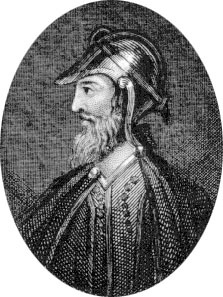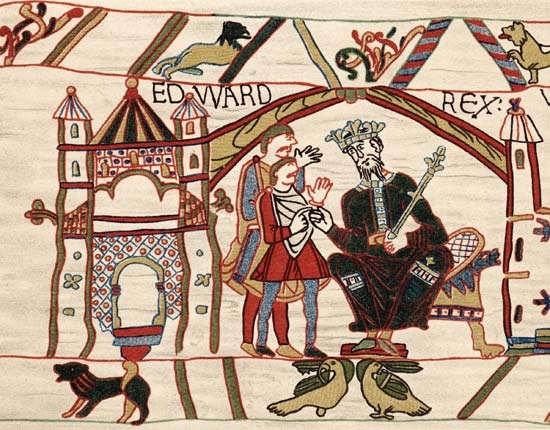Edward
Anglo-Saxon king
byname Edward the Elder
died July 17, 924, Farndon on Dee, Eng.
 Anglo-Saxon king in England, the son of Alfred the Great. As ruler of the West Saxons, or Wessex, from 899 to 924, Edward extended his authority over almost all of England by conquering areas that previously had been held by Danish invaders.
Anglo-Saxon king in England, the son of Alfred the Great. As ruler of the West Saxons, or Wessex, from 899 to 924, Edward extended his authority over almost all of England by conquering areas that previously had been held by Danish invaders.Edward ascended the throne upon his father's death in October 899, and in a battle in 902 his forces killed a rival claimant, Aethelwald, who had allied with the Danes. After defeating the Northumbrian Danes at Tettenhall, he set out in August 912 to subdue the Danes of the eastern Midlands and East Anglia. From 910 to 916 he constructed a series of fortified enclosures around his Kingdom of Wessex.
At the same time, his sister, the Mercian ruler Aethelflaed, constructed a complementary series of fortresses in the northwest Midlands. In 917 Edward and Aethelflaed launched a massive offensive, quickly overwhelming the entire Danish army of East Anglia. Upon Aethelflaed's death in June 918, Edward assumed control of Mercia, and by the end of the year the last Danish armies in the Midlands had submitted. By that time Edward's kingdom included all the land south of the Humber estuary; in 920 he forced the submission of Northumbria. Complete political unification of England was achieved during the reign of his son and successor, Athelstan (reigned 924–939).
king of England 【1006-1066】
byname Saint Edward the Confessor
born 1002/05, Islip, Eng.
died Jan. 5, 1066, London; canonized 1161; feast day originally January 5, now October 13
 king of England from 1042 to 1066. Although he is often portrayed as a listless, ineffectual monarch overshadowed by powerful nobles, Edward preserved much of the dignity of the crown and managed to keep the kingdom united during his reign of 24 years. His close ties to Normandy prepared the way for the conquest of England by the Normans under William, duke of Normandy (later King William I), in 1066.
king of England from 1042 to 1066. Although he is often portrayed as a listless, ineffectual monarch overshadowed by powerful nobles, Edward preserved much of the dignity of the crown and managed to keep the kingdom united during his reign of 24 years. His close ties to Normandy prepared the way for the conquest of England by the Normans under William, duke of Normandy (later King William I), in 1066.Edward was the son of King Ethelred II (reigned 978–1016) and Emma, daughter of Richard II, duke of Normandy. When the Danes invaded England in 1013, the family escaped to Normandy; the following year Edward returned to England with the ambassadors who negotiated the pact that returned his father to power. After Ethelred's death in 1016 the Danes again took control of England. Edward lived in exile in Normandy until 1041, when he returned to the London court of his half brother (Emma was their mother), King Hardecanute. Edward succeeded to the throne in 1042 and quickly seized the property of his mother, who had plotted against his accession. Nevertheless, for the first 11 years of his reign the real master of England was Godwine, earl of Wessex, though Edward preserved his right as king to appoint bishops. Edward married Godwine's daughter Edith in 1045, but by 1049 a breach had occurred between the two men. In 1051 Edward outlawed the Godwine family and dismissed Edith. During this period Edward rapidly lost popularity by giving foreigners—particularly Normans—high positions in his government. Hence, in 1052 Godwine and his sons were able to gather large forces against the king. They compelled Edward to restore their lands and recall Edith as his wife, and they exiled many of his foreign favourites.
Upon Godwine's death in 1053, his son Harold (Harold II) became the most powerful figure in the kingdom. It was Harold rather than Edward who subjugated Wales in 1063 and negotiated with the rebellious Northumbrians in 1065. Consequently, Edward on his deathbed named Harold as his successor, even though he allegedly had already promised the crown to William, duke of Normandy. (Edward had exploited his lack of an heir as a diplomatic tool by promising the succession to various parties.) Indeed, according to Norman accounts, Edward sent Harold to Normandy in 1064 to confirm his promise to William. While en route, Harold was captured by one of William's vassals and may have been ransomed by the duke, who then took Harold on a military campaign in Brittany. Harold swore an oath to William that he would defend William's claim to the English throne. The violation of the alleged oath was one of the justifications used in support of the Norman invasion of England. Harold was killed at the Battle of Hastings (Hastings, Battle of) in Sussex in October 1066, and two months later William ascended the throne.
In the years following Edward's death, his reputation for piety grew, in part as a result of the political needs of his successors. In the late 11th and the early 12th century, Edward's childless marriage came to be understood as the consequence of his devotion to virginity and the chaste life. He was praised for issuing prophecies, and a number of miracles were attributed to him. In the 1130s Osbert of Clare, a monk at Westminster Abbey, where Edward had built a new church, wrote the saint's life the Vita beati Eadwardi regis Anglorum (“Life of the Blessed Edward, King of the English”). In 1161 Pope Alexander III, during his struggle with Frederick Barbarossa (Frederick I) and the antipope Victor IV, was recognized as the legitimate pope by England's King Henry II in exchange for canonizing Edward, and in 1163 the translation of Edward's relics was attended by secular and political leaders of the kingdom. In the later Middle Ages Edward was a favourite saint of English kings such as Henry III and Richard II.
king of England 【936-978】
byname Saint Edward the Martyr
born c. 963
died March 18, 978, Corfe, Eng.; feast day March 18
king of England from 975 to 978. His reign was marked by a reaction against the promonastic policies of his father and predecessor, King Edgar (reigned 959–975). Upon Edgar's death a faction sought to win the throne for his younger son, Ethelred (Ethelred II), but Edward was quickly elected king. He evidently played little part in the antimonastic reaction, which was led by Aelfhere, ealdorman of Mercia. Edward was assassinated while visiting Ethelred in Corfe. Although Ethelred succeeded to the throne, it is not known whether he and his mother Aelfthryth (Edward's stepmother) had a hand in the murder of his brother. Edward was widely mourned; his remains were said to produce miracles, and his cult was promoted by King Canute.
king of Portugal
Portuguese Duarte
born October 30, 1391, Viseu, Portugal
died September 9, 1438, Tomar
king of Portugal whose brief reign (1433–38) witnessed a strengthening of the monarchy through reform of royal land-grant laws, a continuation of voyages of discovery, and a military disaster in Tangier.
A scholarly, sensitive man of high moral character, Edward was known as the philosopher-king and the author of O Leal Conselheiro (“The Loyal Counselor”). He ascended the throne on the death of his father, John I, well schooled in legal principles. Shortly thereafter, Edward promulgated the lei mental (April 8, 1434), which facilitated the recovery of certain previous royal land grants and made others subject to royal confirmation at the start of each new reign.
Edward supported the efforts of his brother Henry the Navigator to explore the west coast of Africa, and he agreed to a plan for Henry to attempt the conquest of Morocco by attacking Tangier. The expedition (1437) was a complete failure, and Edward's youngest brother, Fernando, was captured. The grief-stricken king died shortly thereafter of the plague.
king of Scotland
in full Edward De Balliol, or Baliol
died January 1364, Wheatley, Yorkshire, Eng.
son of King John de Balliol of Scotland and claimant to the title of King of Scots, who was crowned in September 1332. Expelled in December 1332, he was restored in 1333–56, having acknowledged Edward III of England as his lord.
Edward inherited only the family lands in France and his father's claim to Scotland. He was kept in England from 1296 (the year of his father's death) to 1315, after which he lived mainly in France.
In 1332 Balliol led an invasion of Scotland from France by a group of English nobles whose lands in Scotland had been seized by the Scottish king Robert I the Bruce, father of David II (reigned 1329–71). On August 12, in the Battle of Dupplin Moor (Dupplin Moor, Battle of) (q.v.), Edward defeated Donald, earl of Mar and regent for David II (then eight years old), and on September 24 he was crowned king at Scone. On November 23, at Roxburgh, he acknowledged Edward III of England as suzerain over Scotland.
A Scottish coalition under Sir Archibald Douglas defeated Balliol at Annan, Dumfries, on Dec. 16, 1332, but on July 19, 1333, Edward III defeated and killed Douglas in the Battle of Halidon Hill (Halidon Hill, Battle of) (q.v.) on behalf of Balliol, who in payment gave much of the Scottish lowlands to the English king. Balliol's hold on the rest of Scotland against the adherents of David II remained precarious. He resigned his title and all his lands to Edward III on Jan. 21, 1356, and died a childless pensioner of the English sovereign.
- Giovanni Papini
- Giovanni Pascoli
- Giovanni Pastrone
- Giovanni Pico della Mirandola, Conte Di Concordia
- Giovanni Pierluigi da Palestrina
- Giovanni Pisano
- Giovanni Pontano
- Giovanni Segantini
- Giovanni Sgambati
- Giovanni Verga
- Giovanni Villani
- Giovanni Virginio Schiaparelli
- gipon
- Gipp, George
- Gippius, Zinaida Nikolayevna
- Gippsland
- giraffe
- Giraldi, Giambattista
- Giraldus Cambrensis
- girandole
- Girard Desargues
- Girardin, Émile de
- Girardon, François
- Girardot
- Girard, Stephen